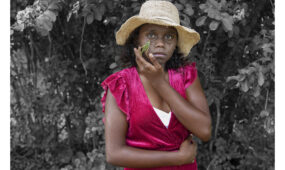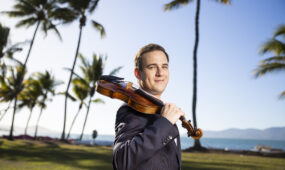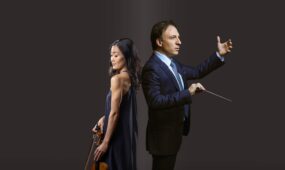Arts versus sciences: ‘the two cultures’
InReview
What are the roots of antagonism between the arts and sciences? Professor Julian Meyrick revisits the ‘two cultures debate’ – and the men at its centre – ahead of a free lecture tonight exploring the oceanic divide between the two domains.

Some things are important in themselves, some for the reactions they provoke. Even people who have never heard of the novelist and physicist CP Snow, or the doyen of English literary criticism FR Leavis, have heard the phrase “the two cultures”.
It was first used by Snow in an article for the New Statesman in 1956, but enjoyed world-wide circulation after he delivered a Rede lecture of the same name at Cambridge University in 1959.
The thrust of Snow’s argument is simple, if not simplistic. He says the intellectual world contains two domains, the arts and the sciences, which were ignorant of each other’s ideas, methods, aims and achievements. But – the sting in the tail – arts’ ignorance of science, is the more egregious, given the future requires science and technology to take precedence if society is to continue progressing.
It took three years for Leavis to respond, but when he did he used language of such uncompromising severity and personal censure that, by the standards of the day, he was perceived to have broken all rules of public debate (it seems quite mild now).
He thumped Snow not only for his block-headed view of culture, but for the asinine assumption that a better life is the same as economic prosperity. For Leavis, it is language and literature, not science and technology, which provide the essential core of our existence.
Sixty years later, it is easy to see that Snow and Leavis were, in their different ways, both right and wrong. It is harder to say what the relationship between the two cultures should ideally be, or how the divide – which, if anything, has grown wider – can be bridged.
Both men had an enormous impact in the field of education. Leavis decisively contributed to, if he did not found, the modern conception of English literary studies. Snow successfully promoted the cause of science at a time when the British university system was undergoing substantial reform. The spill-over of their acrimonious debate has touched the lives of us all.
But while the controversy is important, it is the men themselves I find intriguing – so similar, yet so different. Both from lower-middle-class families, they made their way up entirely on their own merits. Both studied at Cambridge University and were marked by world war, but by different ones. Leavis, 10 years older, was a stretcher-bearer in World War I; Snow was a science administrator in World War II.
In her Memoirs of the Emperor Hadrian, the author Marguerite Yourcenar says that if you want to understand someone, read the books in their library. Part of my summer was spent perusing DH Lawrence, Leavis’ favourite author, and Anthony Trollope, who was Snow’s. The differences between the writers clarify those of our two cultures antagonists.
Lawrence’s Sons and Lovers, published in 1913, has a signal place in Leavis’s pantheon of great literature. You cannot say it is a book without politics. But the politics are about nature, gender and family. After Leavis’s attack on Snow, the accusation hurled at him was that he was a Luddite, that his views were a reactionary longing for dale, squire and cottage industry.
It’s a ludicrous charge. To read Sons and Lovers is to read a treatise on botany (apart from anything else) and to gain an insight into the working life of a Derbyshire mining town. Industrial progress isn’t denigrated. But nor is it the point of life, which is seen to lie elsewhere, in the personal, particularly sexual relations. Nature is the constant, all-pervasive force. The struggle for a meaningful existence is one that involves mothers, fathers, brothers, daughters, lovers and sons, living in intimate familiarity.
Phineas Finn, by contrast, published in 1897, is the second in Trollope’s Palliser series of Parliamentary novels. It is about an ambitious young Irishman who finds himself fortuitously elected to Britain’s House of Commons in the 1860s, a time of violent agitation for universal suffrage (though not for women, of course).
Trollope’s prose is richly descriptive of the professional classes of the mid-Victorian period, a time of rapid industrial and social transformation. Like Lawrence, he is concerned with personal relations, but his focus is the wider structures that determine these. If Lawrence writes about sex and the emotions, about love, Trollope writes about systems and processes, about power.

Get InReview in your inbox – free each Saturday. Local arts and culture – covered.
Thanks for signing up to the InReview newsletter.
Leavis always saw himself as an outsider, even at the height of his authority. He achieved academic success slowly and never seemed to care about it much.
Snow was an inveterate gong-gatherer. He received 20 honorary degrees, a knighthood in 1957 and a life peerage in 1964. He was also a private secretary in the Ministry of Technology in the first Harold Wilson government.
Leavis just taught generation after generation of the brightest students he could get his hands on. It is interesting to speculate which was the more influential strategy in the end.
Julian Meyrick, Strategic Professor of Creative Arts at Flinders University, will deliver a free lecture titled A Marriage made in Heaven but Living in Hell tonight (March 16) in the Lyrics Room at the Adelaide Festival Centre (details here). Part of a monthly series of free lectures, he will consider the roots of the antagonism between the arts and sciences, the place of Leavis and Snow’s arguments in higher education today, and how the divide between the two realms can be crossed.
Support local arts journalism
Your support will help us continue the important work of InReview in publishing free professional journalism that celebrates, interrogates and amplifies arts and culture in South Australia.
Donate Here





Comments
Show comments Hide comments